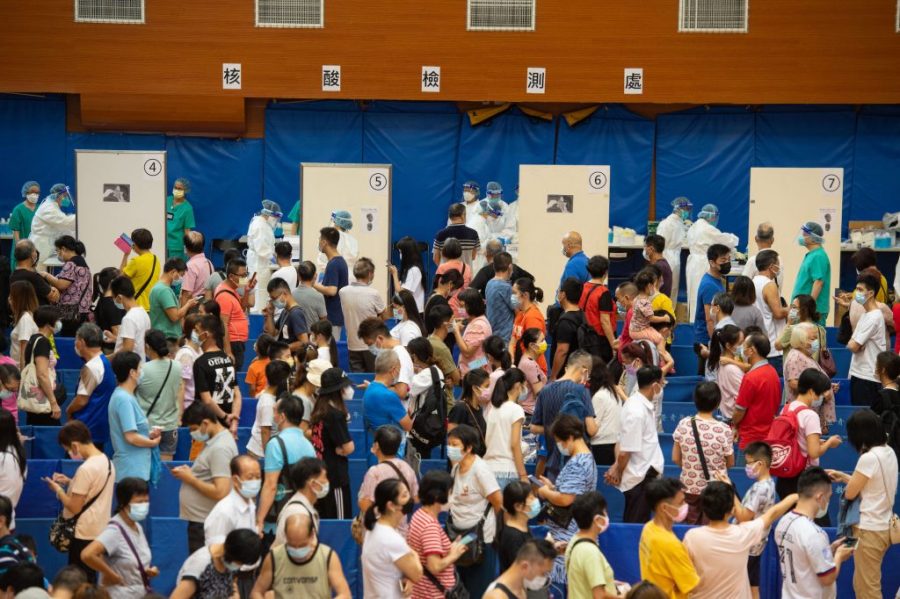Health officials have devised improved plans if Macao needs to embark on a second mass nucleic acid testing (NAT) drive, including more testing stations and a back-up system for the Macao Health Code.
Health Bureau (SSM) Director Alvis Lo Iek Long said that more than half the testing stations would be free, however others would charge for the test, whose result could be used to cross the Macao-mainland border.
If a second mass NAT drive goes ahead, it will be completed in three days and the government will release testing station queueing times every 15 minutes,
According to Lo, the improved NAT drive plan has five major aspects.
First, Lo said, the government will strengthen coordination among all related public entities involved in a mass Covid-19 testing programme. Lo said that the government has set up a working group for the possible implementation of a citywide testing programme, which is headed by Secretary for Social Affairs and Culture Elsie Ao Ieong U. The working group is divided into five sub-groups responsible for medical, registration, maintaining order at the various testing stations, logistics, and the release of information.
The second aspect is about improving service procedures, Lo said, adding that the government will increase the number of testing stations and swab collection points, allocate some as “caring” stations for certain groups of people such as senior citizens, and allow residents to choose the methods of swab collection when booking a test.
The third aspect concerns strengthened human resources, Lo said, pointing out that the SSM has recruited 650 medical volunteers from the private sector for a mass NAT drive, while the Education and Youth Development Bureau and the Social Welfare Bureau have jointly recruited over 2,000 volunteers to carry out various assistance and supportive tasks during a mass testing programme.
The fourth aspect is about improving the booking procedures, Lo said, noting that in addition to allowing residents to choose testing stations and swab collection methods in advance, the government has also set up backup systems in case of the possible malfunctioning of the Macao Health Code system and the mass testing programme booking system.
The fifth aspect, Lo said, is that the government will regularly release real-time information about the various testing stations, such as the expected waiting time for a test. The task will be carried out by officials in the public security portfolio.
The first mass NAT drive early this month was carried out at 42 testing stations across the city, comprising 269 swab collection points.
Lo said that in case of a second NAT drive, the government will increase the total number of testing stations by 10 to 52 and the total number of swab collection points by 98 to 367.
Lo said that 31 of the 52 testing stations will be designated for a free test, while 14 will be earmarked for a paid test whose result could be used for travel between Macao and the mainland.
Lo said, the remaining seven stations will be “caring” stations which are earmarked for those who are unable to make an appointment, so they can take a walk-in test.
Under the improved plan, Lo said, those with a yellow Macao Health Code will be allowed to undergo a test at the various testing stations under a mass NAT drive, but those with a red Macao Health Code must undergo their Covid-19 test at the Conde de São Januário Hospital Centre.
In addition, Lo also said that the government has bought 700,000 throat swabs, and 700,000 nose swabs, which will be available at all testing stations.
Lo said that the government has set up a backup system at the data centre run by the Administration and Civil Service Bureau in case the Macao Health Code system breaks down, and a backup system in case the mass testing programme booking system malfunctions. Lo said that in case the two systems encounter problems, their operation can switch to the backup systems in 15 minutes.
With the exception of “caring” NAT stations, people must make an appointment before undergoing a test at the other two types of testing stations.
Education and Youth Development Bureau Deputy Director Kong Chi Meng said that the “caring” NAT stations can only be used by children aged three or below, seniors aged 80 or above, pregnant women, and holders of a Disability Assessment Registration Card or those with reduced mobility. He underlined that only those who are really unable to make an appointment can use the “caring” stations.
Kong said that “caring” lanes will be set up at the “general” NAT stations for the four groups of people, suggesting that they can choose to make an appointment for a test at the “general” NAT stations with the assistance of their family members or friends, in which case they can use the “caring” lanes at the “general” NAT stations.
According to Kong, real-time information about the expected waiting time at the various testing stations will be indicated in three colours, namely green for a wait of less than 30 minutes, yellow for a wait of between 31 and 59 minutes, and red for a wait of at least an hour. The information will be available on the mass testing drive’s booking system, The Macau Post Daily reported.






